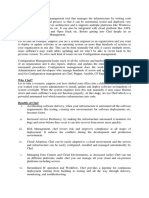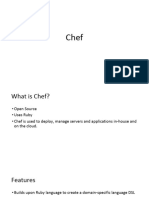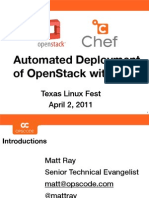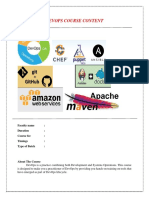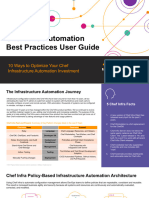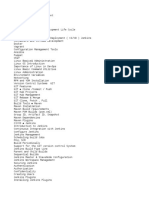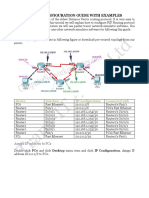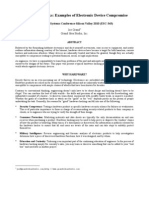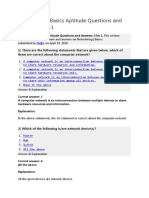Ansible vs. Chef vs. Puppet vs.
SaltStack: A comparison
Consistent configurations enable the many machines, servers and applications in use across an
organization to function properly. Configurations also bolster security and performance.
A configuration management tool thus is an important feature in IT operations. But how do you
evaluate your options?
Many IT teams can agree on some common principles. Core features must be intuitive to use.
Tools must include meaningful visualizations. Automation is a critical ingredient in the mix, as
manual methods are time-consuming and error-prone. Configuration managers also shield
companies from potential compliance troubles. Additionally, a configuration management tool
helps:
Push updates and patches to applications and settings;
Modify key sets of configurations; and
Scan systems to inspect loaded software versions.
The best configuration management tools have most (or all) of this functionality baked in.
Here's a look at four popular configuration management products.
Ansible
Red Hat Ansible's pitch is straightforward: Redefine how simple IT deployments can be. Ansible
is first and foremost an automation platform. Accordingly, the software excels at system
maintenance and management for the following:
cloud ecosystems
applications
networks
containers
security
While Ansible cannot be installed on a machine running Windows, it's compatible with
numerous operating systems. These include nine leading flavors of Linux (RHEL, CentOS,
Fedora, Ubuntu, Debian, Gentoo, Arch, Slackware and Clear) and three Unix derivatives
(macOS, FreeBSD and Solaris). Ansible also relies on Python and is thus installable via pip.
Ansible is open source and uses procedural language for ad hoc commands or declarative
configurations via modules. This is a hybridized approach.
The Ansible manager is agentless, meaning no middleware is required. The user can set
automations using a password or SSH key and essentially wait for data to roll in, with no extra
�oversight duties needed. Configurations within Ansible are data descriptions. They're meant to
be read by humans and computers alike, to the point where new users won't feel lost.
Additionally, Ansible can run as a remote configuration manager on a single machine. As the
control node, this machine can control many other machines within the environment.
Red Hat
A sample Ansible Tower dashboard
Ansible avoids traditional, error-prone scripting approaches by working toward desired states. If
the computers within a network aren't updated to reflect an OS version (or include key
applications), the software automatically remedies this issue. Other configuration managers
might show the path necessary to achieve the same thing, but that puts the onus on IT teams,
adding a task instead of removing one.
A central goal for configuration is the use of modules, which support certain actions and
contextual automations. IT professionals can choose from over 1,300 modules in Ansible's main
distribution.
�Chef Infrastructure Management
Chef's Infrastructure Management products are made to deploy automation across cloud
ecosystems, physical ecosystems or virtual machines. The management workflow includes a
central workstation, which pushes instructions and more to a distribution server, which then
passes those actions onward to targeted systems. These machines (remote or local) are
destination nodes. Chef functionally lives on the server, though automations are established via
the central node. The company offers AIOps support, thus opening the door for third-party
integrations -- including platforms such as Zenoss, Moogsoft and Splunk Enterprise. While not
exclusive to Chef, available integrations have made it easier for users to scale with greater
visibility.
Chef's agent-based approach helps nodes be "autonomous actors" after setup, an important
benefit according to the company. That's not to say that agentless alternatives are inherently
inferior -- the agent model simply works better for high-profile industries where security is
paramount, such as finance, healthcare, insurance and government. Chef shines when deployed
within these environments.
The tool is made to help with scalability as organizations -- and their networks -- expand. Since
these changes and others might introduce inconsistencies, remediation is needed. With Chef,
teams can execute changes automatically, though they also have the option to test critical
changes prior to implementation. Chef says these dry runs help to prevent errors or assess
viability.
Whether your infrastructure runs on Azure, AWS, Google Cloud or otherwise, Chef won't force
a switch. Chef officially supports the following operating systems and platforms:
Unix (AIX and Solaris) and two Unix variants (macOS and FreeBSD);
eight Linux distributions (Amazon, CentOS, Debian, Oracle Enterprise, Red Hat
Enterprise, SUSE Server, Ubuntu LTS); and
Windows.
The Chef community provides unofficial OS-support packages, which are acknowledged within
the tool's documentation. These include non-LTS versions of Ubuntu, Arch Linux, Fedora,
Gentoo, openSUSE, Scientific Linux and Windows Server (semiannual channel). Teams that
maintain ecosystems using any of these OSes may do so successfully, but organizations that
oversee sensitive information should carefully evaluate their options. Chef is configurable via
Ruby and uses procedural language. It's also open source.
�Puppet Enterprise
Puppet Enterprise is another agentless tool that champions simplicity. It welcomes existing
automation code, which enables developers and IT professionals to hop aboard without the steep
learning curve common with feature-rich software.
Service stability and reliability are two chief focus areas. Puppet Enterprise's architects claim the
tool can reduce change failure rates by 2.5 times. Automation management in this case centers
on reducing the need for remediation, though Enterprise will show users what needs fixing. By
committing more changes that work effectively, Puppet aims to reduce errors and free up IT staff
for other tasks. To accomplish this, Puppet Enterprise sends configurations to servers within the
managed environment. From there, it can push changes to other downstream machines. If a
configuration changes, Puppet defers to the predetermined configuration on the host machine.
As does Chef, Puppet Enterprise uses infrastructure as code. The tool uses state enforcement akin
to Ansible, which offloads any core oversight tasks to defined automations. Not only that, Puppet
Enterprise allows admins to manage 2.3 times more resources than they would've previously, and
manage them more seamlessly, according to the company. This ultimately yields meaningful
costs savings.
Puppet
Example of Puppet Enterprise showing Nodes.
Puppet Enterprise can connect to any device locally or remotely. Those devices can also run
almost any modern OS or distribution, via SSH or WinRM. To keep certain functions
safeguarded, Puppet institutes role-based access controls.
�Puppet supports the following automation languages: PowerShell, Bash, Python, Ruby and
YAML.
Puppet's configurations are considered declarative, following the same state management mantra
shared by other configuration managers. Users can also code automations using Puppet's
proprietary domain-specific language.
SaltStack
SaltStack makes the case that its key value proposition is its ability to harness event-driven
automation across an entire ecosystem. This is a benefit when scaling an environment, as
additional complexity essentially necessitates reactive measures.
Automated scripting and state-driven actions help mitigate potential problems. Integrations, drift
and preexisting policies can cause problems, and SaltStack adapts effectively to these variables.
The manager effectively handles common, complex hurdles, such as:
multistep patching procedures;
restarts;
integrated workflows; and
IT service management, configuration management database and record updates.
SaltStack works with public clouds, private clouds, on-premises setups and even containers. This
means that teams can deploy SaltStack atop nearly any leveraged technology. The configuration
manager seeks to boost reliability and performance across any environment.
SaltStack's setup is somewhat unique. The configuration manager features two agent-based
operative pathways -- using smart agents called minions, or proxy agents. Communication is
achieved through an event bus. Those who prefer an agentless setup can opt for SSH/WinRM
protocols which promote direct configuration. All automations and actions stem from the central
machine.
Teams can manage SaltStack's configuration files through SaltStack Enterprise or their preferred
code repository. Additionally, configurations integrate with existing CI/CD pipelines.
SaltStack supports a variety of major and minor operating systems, including:
Windows
Linux (Red Hat, Ubuntu, Debian, CentOS, SUSE)
Unix (AIX, Solaris, macOS)
The manager is Python-based, but also supports human-friendly YAML. SaltStack claims that
switching from Ruby-based alternatives can reduce the amount of requisite coding by up to 10
times.
�SaltStack supports both imperative ordering and declarative configuration execution. This
combines a state-based approach with requisites.
Differences between Ansible vs. Puppet vs. Chef vs. SaltStack and how to choose
Choosing the right configuration manager doesn't mean an organization needs to seek out the
best tool on the market. What is best for one company may be wrong for a different company.
Every configuration management tool, including Ansible, Chef, Puppet and SaltStack, caters to
specific organizational goals and preferences.
Ansible and Puppet, for instance, are agentless; Chef is not. With SaltStack, users have choices
about the use of agents.
If an organization has rigid OS requirements, that will dictate which tools to give a close look
and which to cross off the list.
Some of the selection process is about comfort, not architectural fit. Consider programming
languages. A team that's not skilled in Python, for example, might not be as comfortable with
Ansible as one that knows that language well. If PowerShell is of high importance to your team,
you will probably want to give a close look at Puppet Enterprise.
In the end, the strengths and competencies of a team will determine which configuration product
will be most suitable.










